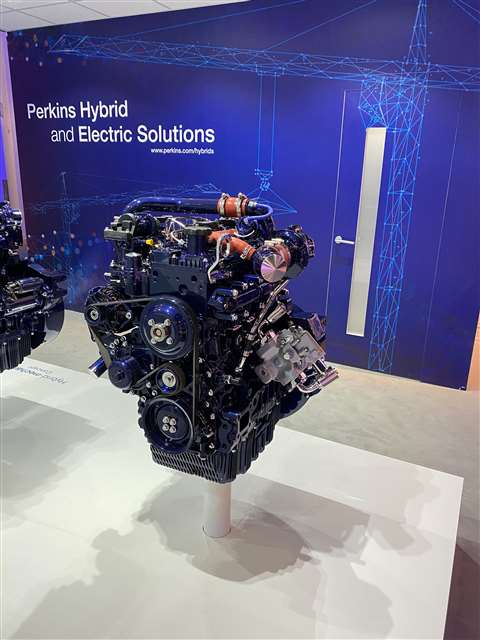How new powertrains are impacting construction
21 September 2021
Alex Woodrow, Managing Director of specialist powertrain consultancy and CEA member Knibb Gormezano and Partners, examines the future of low-emission powertrains for off-highway vehicles and construction machinery.
Investment in a post-Covid recovery worldwide has created a sharper focus on climate change and the shift to net zero.
 Alex Woodrow, Managing Director of the off-highway technology consultancy Knibb, Gormezano and Partners (KGP).
Alex Woodrow, Managing Director of the off-highway technology consultancy Knibb, Gormezano and Partners (KGP).
Although the industry had slowly started to de-carbonise, we now see the trend rapidly accelerating and the impact on construction equipment, and specifically the powertrains installed in its machines, will be even more significant than reducing noxious emissions over the next decade.
Internal combustion engines (ICEs) that currently run over 95% of machines worldwide will see a further evolution through the ‘20s but will increasing compete with zero tailpipe emission machines.
The high energy demands of many machines mean OEMs will need to consider low carbon liquid and gaseous fuels to continue running the cleaner and more efficient ICEs.
In the short term this will be a minor incremental change, but over this decade could see the diesel engine replaced in many sub-segments and end uses.
Commercial vehicle electrification
In the commercial vehicle segment (heavy trucks and buses) global CO2 and Greenhouse Gas (GHG) regulations, combined with the introduction of Zero and Low Emission Zones (ZEZ/LEZs) in many cities, is seeing steadily increasing volumes of fully electrified trucks.
Several heavy truck OEMs in Europe have indicated they will pivot away from fossil fuel ICEs by 2040. This will pull construction equipment OEMs, which are increasingly being pushed by their customers.
Balancing Corporate Social Responsibility and CO2 targets
Many end customers are having to set higher CO2 reduction targets in their Corporate Social Responsibility (CSR) guidelines.
Without specific CO2 legislation the driver for non-road machine electrification is very dependent on these end users for demand of zero emission machines.
With a high share of rental and sub-contract machine use, most purchases of new machines are not made by the operator.
Construction companies will increasingly need to be driven by CO2 reduction across their job sites, with the end customer for construction demanding zero emission or reduced CO2 emissions. This is increasingly important and driving electrification in various segments.
The complexity of job-sites and the wide range of machine usage cycles will make it difficult to legislate out CO2 from construction machinery in the short and medium term.
However, where machines are used indoors, in cities or where noise limits restrict usage hours electrified machines are increasingly being adopted.
Total Cost of Ownership is still the primary buying factor
 Komatsu’s electic mini excavator
Komatsu’s electic mini excavator
For the broader market, where CSR is not a priority, Total Cost of Ownership (TCO) is most often the prime consideration when buying a new machine.
To create a representative sample KGP is currently researching TCO across 30 segments in 15 major markets as part of its Fuels 2030 programme for Commercial Vehicle and Non-Road machinery.
Whilst early adopters will pay the ‘green premium’ for low carbon machines, for larger fleets and those that are more cost sensitive the adoption will be slower and depend on various factors.
Fuel cost remains the largest single operating expenditure (OPEX) for many fleets, and electrification and low carbon solutions will have to be competitive here, in lieu of Zero Emission Zones covering entire countries.
In many commercial vehicle segments, especially medium duty urban delivery, the TCO will favour battery electric trucks in mid-late 2020s.
The additional cost of charging infrastructure for machines in remote locations, plus demand charges for high power rates, means that the tipping point for non-road machines could be later, closer to 2030.
However it is likely to be influenced by the additional cost of any shift to Stage VI noxious emissions. Future noxious emissions legislation is expected post 2026 and may tip the balance in favour of zero and low carbon fuels.
How economies of scale may be a challenge for fuels, infrastructure and powertrain components
A key issue that faces the industry is that there are currently many economies of scale for powertrain across automotive segments.
 Perkins’ hybrid engine solution at Conexpo 2020.
Perkins’ hybrid engine solution at Conexpo 2020.
Depending on their size, non-road machinery engines share some technical commonality in the supply chain with commercial vehicles and in some cases passenger cars and light commercial vehicles.
There will be some cost benefit from sharing electrification technologies.
However, the costs of cleaner diesel powertrains are inevitably going to be shared across a smaller volume than in the past.
With China and India shifting closer to Stage V and having a net zero target of 2060, rather than the 2050 in Europe and the US, there will be a period where ICE remains in the majority.
Shifting to lower carbon diesel will be required as the hydrogen and electricity network may be suitable for on-road automotive applications, but less resilient and accessible for non-road machines.
Infrastructure challenges of using green equipment
eFuels, promoted as a possible lifecycle extension for ICE are possible, but need scale to increase availability, much in the same way low hydrogen prices will not be achieved without a massive increase in investment.
The debate therefore is which segments will use what fuels.
It is argued in many circles that hydrogen is not sensible as green hydrogen has lifecycle efficiencies much lower than battery electric driven machines.
Nevertheless, it is clear there are usage cases where electric will be a major challenge.
The high load factors of machine powertrains are an order of magnitude greater than passenger cars, for example.
With a 100kW tractor at 50% load factor an all-electric shift would require a battery of the order of 500kWh, with a similar fast charger at 1MW.
This may be possible, albeit expensive, in the farmyard, but it is not practical for a tractor to return to base, charge for an hour then return to the field.
Therefore in the construction equipment industry we really need a systems approach to energy and energy usage for these machines, not necessarily a solution optimized for lowest fuel cost or CO2 based on fuel and infrastructure cost alone.
Without optimizing for machine type the solutions from government and other stakeholders might not be the most efficient in terms of productivity, capital investment and usage for farm, construction, and related applications.
About Knibb, Gormezano and Partners
Knibb, Gormezano and Partners (KGP) are a specialist automotive consultancy focused on powertrain technology in the Commercial Vehicle (3.5t GVW+) and Non-Road Mobile Machinery segments. Since our foundation in 1988 we have helped over 500 companies worldwide grow and globalise.
STAY CONNECTED


Receive the information you need when you need it through our world-leading magazines, newsletters and daily briefings.
CONNECT WITH THE TEAM










